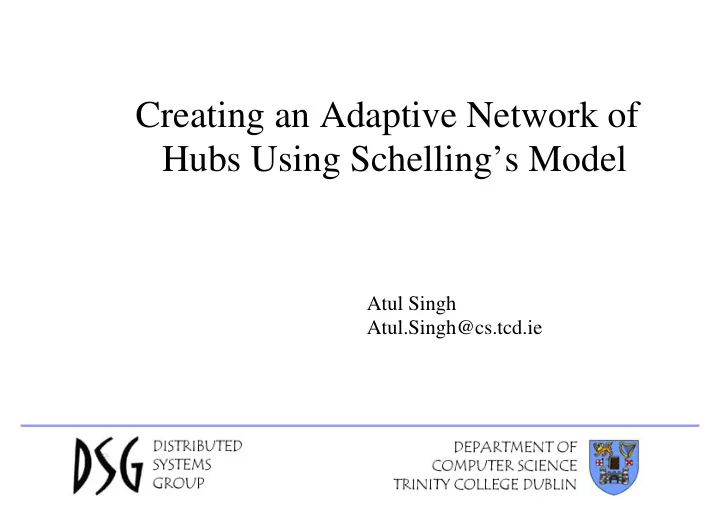

Creating an Adaptive Network of Hubs Using Schelling’s Model Atul Singh Atul.Singh@cs.tcd.ie
Contents ● Peer-to-Peer ● Schelling's Work ● Algorithm ● Case Study ● Simulations
Peer-to-Peer ● Distributed systems without any central control, where all the nodes are equivalent in functionality. ● Overlay Network Topology. ● Lack of central control makes it difficult to develop efficient algorithms for P2P networks.
Peer-to-Peer (cont’d) ● Suboptimal grouping of peers. ● Adapting topology to satisfy certain criteria when peers leave or join the network. ● Work presented is applicable for decentralized unstructured networks only.
Contents ● Peer-to-Peer ● Schelling's Work ● Algorithm ● Case Study ● Simulations
Schelling's Work ● Thomas Schelling is an American Economist. ● In 1960, he suggested that segregated neighborhood is an emergent behavior caused by the desire of people to have a very small percentage of similar neighbors. ● No central control. ● Lack of global picture. ● Variations possible.
Contents ● Peer-to-Peer ● Schelling's Work ● Algorithm ● Case Study ● Simulations
Algorithm • calculateSatisfaction() uses a satisfaction criteria to determine a peer’s satisfaction state. • executeAdaptation is used to execute the topology adaptation steps .
Algorithm (cont’d) Satisfaction Criteria Topology Adaptation Steps count ( same property ) * 100 / count ( all ) > PNSP Step 1: where, PNSP is the desired percentage of neighbours drop ( neighbour ( different property )) with similar property. Step 2: add ( search ( same bandwidth )) Same as above drop ( neighbour ( different property )) Two set of satisfaction criteria and topology adaptation steps that can be used to bring together peers with similar properties (e.g., bandwidth)
Contents ● Peer-to-Peer ● Schelling's Work ● Algorithm ● Case Study ● Simulations
An Adaptive Network of Hubs ● Super peers used to reduce bandwidth usage (e.g., KaZaA). ● Failure of super peers can be catastrophic. ● Ordinary peers are connected with each other and to more than one super-peer.
Adaptive Network of Hubs (cont’d) Peer Satisfaction Criteria Topology Adaptation Steps Hub H max > count ( hub ) and count ( hub ) != 0 Step 1: if ( count ( hub ) > H max ) Where, H max is the maximum number of hubs drop ( neighbor ( hub )) desired as neighbors. Step 2: if ( count ( hub ) == 0) add ( search ( hub )) count ( hubs ) > 0 Normal Step 1: if ( count ( all ) == maxNeighbors ) drop ( neighbor ( any )) Step 2: add ( search ( hub ))
Contents ● Peer-to-Peer ● Schelling's Work ● Algorithm ● Case Study ● Simulations
Simulations Step 1: • The algorithm on the left is used Peer p = newPeer (random() =< 0.9 ? “peer” : “hub” to create the random network on Step 2: which the simulations are p.maxConnections = p.type == “hub” ? 20 : 5 performed. Step 3: • Search operation is performed p. add ( select (3)) using a Depth First Search (DFS) Simulations have been performed on : •Static Overlay Network. •Dynamic Overlay network with a a constant influx of peers.
Static Overlay Network ● Simulations done on four different random networks of 100, and 1000 peers each using H max values from 1 and 10. ● A critical value of H max (called H maxCritical ) was observed below which all the peers are not satisfied.
Dynamic Overlay Network ● Simulations start with a small random network of 100 peers and 5 new peers are added every iteration till the number of nodes reaches 5000. ● Used a H max value of 5.
Dynamic Overlay Network (cont’d) H Set of hubs P Set of peers E H,H Set of edges connecting two hubs E P,P Set of edges connecting two peers E H,P Set of edges connecting a hub and a peer hub-hub degree = |E H,H | / |H| peer-peer degree = |E P,P | / |P| hub-peer degree = |E H,P | / |H| peer-hub degree = |E H,P | / |P|
Dynamic Overlay Network (cont’d)
Conclusion ● Schelling’s Algorithm can be used for topology adaptation. ● An adaptive network of hubs can be created using a variation of the Schelling’s Algorithm.
Thank You!
Recommend
More recommend